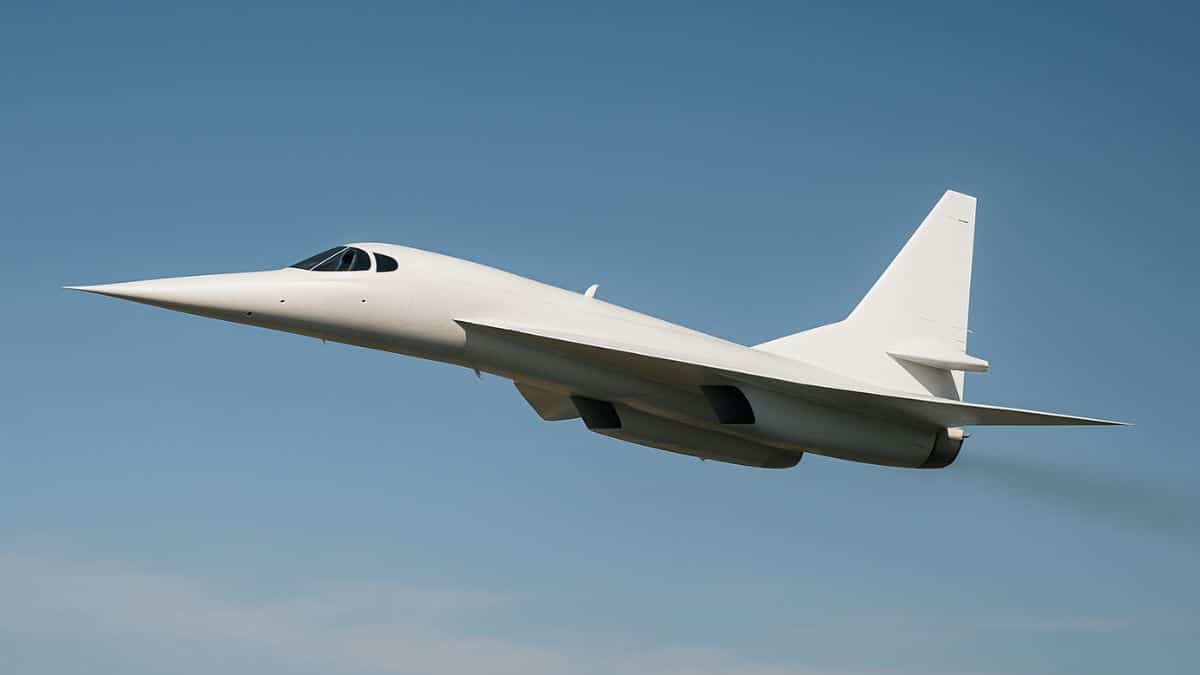The aviation industry witnessed a monumental breakthrough on February 10, 2025, as Boom Supersonic’s XB-1 aircraft accomplished what many experts deemed impossible. Flying over the Mojave Desert at speeds exceeding the sound barrier, the aircraft achieved something unprecedented in aviation history: supersonic flight without generating a sonic boom. This revolutionary achievement has opened new possibilities for the future of air travel.
Breaking the sound barrier without the boom
For decades, the notorious sonic boom has been the Achilles’ heel of supersonic travel. When aircraft exceed the speed of sound (approximately 761 miles per hour at sea level), they create powerful shock waves that culminate in the distinctive thunderous crack heard on the ground. This disruptive phenomenon has historically restricted supersonic flights to ocean routes, as demonstrated by the iconic Concorde.
Boom Supersonic’s XB-1 has changed this narrative through its implementation of Mach cutoff technology. This innovative approach exploits atmospheric conditions to redirect shock waves upward rather than toward the ground. By carefully selecting specific flight altitudes and analyzing atmospheric data, the aircraft effectively minimizes the impact of these pressure waves.
The recent test flight’s success was meticulously documented using advanced Schlieren photography, which visually captured the aircraft’s shock wave patterns. These images provided concrete evidence of the technology’s effectiveness, showing how the waves dispersed without forming the concentrated pressure front that creates sonic booms.
Blake Scholl, CEO of Boom Supersonic, emphasized the significance of this achievement: “What we’ve accomplished isn’t just a technological milestone—it’s the key that unlocks a new era of commercial aviation where speed doesn’t come at the expense of tranquility.”
In 2019, Iceland Approved the 4-Day Workweek: Nearly 6 Years Later, All Forecasts by Generation Z Have Come True
At 94, He’s One of Apple’s Biggest Shareholders, and Doctors Can’t Explain How He’s Still Alive-Coca-Cola and McDonald’s Are Part of His Daily Routine
The science behind silent supersonic flight
To appreciate the magnitude of this breakthrough, understanding the physics involved is essential. When aircraft travel at supersonic speeds, they compress air molecules faster than they can naturally move away, creating a pressure wave. Traditional supersonic aircraft produce two distinct shock waves—one at the nose and another at the tail—which merge during flight to create the characteristic double-boom effect.
The XB-1’s innovative approach works through several complementary mechanisms:
- Strategic aircraft design that distributes pressure waves more gradually
- Precise altitude selection to leverage atmospheric refraction
- Advanced computational modeling to predict and mitigate shock formation
- Continuous real-time adjustments during flight based on atmospheric conditions
This technology represents a significant advancement from previous attempts at quieting sonic booms. While earlier projects focused primarily on reducing boom intensity, the XB-1 effectively eliminates the ground-level impact altogether, representing a quantum leap in supersonic technology.
It races through the universe at 300,000 km/s - and never runs out of energy
Beneath your feet: an ancient forgotten continent resurfaces in Europe
Economic hurdles and future prospects
Despite the technical triumph, significant economic challenges remain before silent supersonic travel becomes mainstream. The XB-1 currently reaches speeds of approximately 750 miles per hour, with future iterations aiming for Mach 1.7 (around 1,300 mph). However, the costs associated with implementing Mach cutoff technology presently exceed those of traditional flight methods.
| Flight Type | Approximate NYC to LA Time | Relative Operating Cost |
|---|---|---|
| Traditional Subsonic | 5-6 hours | Baseline |
| Supersonic (Concorde-era) | 2-3 hours | 3-4x higher |
| Silent Supersonic (Projected) | Under 2 hours | Initially 5-6x higher |
The economic viability of silent supersonic travel will depend on technological refinement, cost reduction strategies, and market acceptance. The Concorde’s commercial failure serves as a cautionary tale, demonstrating that technical capability alone doesn’t guarantee success. For Boom Supersonic to succeed where the Concorde failed, they must address both regulatory considerations and market dynamics.
Nevertheless, the prospect of drastically reduced travel times—potentially cutting transcontinental flights to less than half their current duration—presents compelling possibilities for business travelers, emergency services, and luxury tourism. If the economic equation can be balanced, this technology could transform global connectivity in ways previously confined to science fiction.
As Boom Supersonic continues refining its technology, the aviation industry stands at the threshold of a new era. The dream of faster-than-sound travel, which seemed permanently grounded with the Concorde’s retirement in 2003, has been dramatically revitalized. The silent supersonic revolution may well reshape our understanding of distance and global connectivity in the coming decades.







